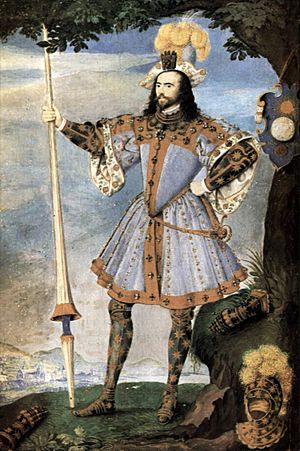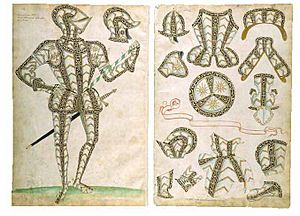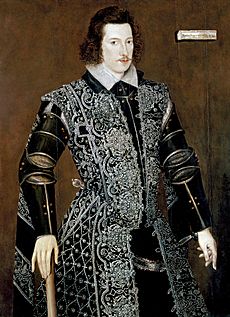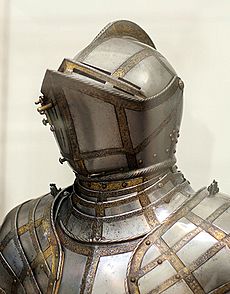Accession Day tilt facts for kids

The Accession Day tilts were exciting yearly events held at the court of Elizabeth I of England. They celebrated her Accession Day on November 17th, also known as Queene's Day. These tilts were a mix of plays and jousting. In them, Elizabeth's courtiers (people who worked for the queen) tried to impress her. They wore amazing symbolic armour and costumes. They also performed poetry and pageants to praise the queen and her country, England.
The last Accession Day tilt during Elizabeth's reign happened in November 1602. The queen passed away the next spring. These tilts continued for King James I on his Accession Day, March 24th. They stopped in 1624, the year before he died.
Contents
How the Tilts Started

Sir Henry Lee of Ditchley, who was the Queen's Champion, created the Accession Day tilts. These events became the most important court festival during the Elizabethan era from the 1580s onwards. The celebrations probably began in a less formal way in the early 1570s.
By 1581, the Queen's Day tilts had grown into a huge public show. They were bigger than any other court festival. Thousands of people came to watch, and the public could get in for a small fee. Sir Henry Lee managed these yearly events until he retired as Queen's Champion in 1590. He then passed his role to George Clifford, 3rd Earl of Cumberland.
After Lee retired, the Earl of Worcester helped organize the tilts. He was the Master of Horse. The queen's favorite, the Earl of Essex, also helped. However, Sir Henry Lee still acted as a sort of Master of Ceremonies because the queen asked him to.
The pageants took place at the tiltyard at the Palace of Whitehall. The royal family watched the events from the Tiltyard Gallery. A special platform with stairs was built below the gallery. This made it easier for the knights to present themselves to the queen.
Who Took Part in the Tilts?

Knights and Their Performances
Records of the Accession Day pageants still exist today. These records show that most of the jousters were from the Queen's Gentlemen Pensioners. Important members of the court also took part. These included the Earl of Bedford, the Earl of Oxford, the Earl of Southampton, Lord Howard of Effingham, and the Earl of Essex.
Many of these participants had fought in real battles in Ireland or other parts of Europe. However, the tilts were more about fun and romance than serious military training. Sir James Scudamore, a knight who jousted in the 1595 tournament, became famous. He was called "Sir Scudamour" in Book Four of The Faerie Queene by Edmund Spenser.

Knights entered the spectacle in special pageant cars or on horseback. They were dressed up as heroes, romantic figures, or symbolic characters. Their servants wore fancy dress that matched the knight's theme. A squire would present a cardboard pageant shield to the Queen. This shield had the character's symbol or impresa on it. The squire would then explain the meaning of the knight's disguise in prose or poetry.
The participants spent a lot of money to create their themes. They ordered special armour and costumes for their followers. Sometimes, they even hired poets, writers, or professional actors to help with their performances.
The themes often included ideas from ancient Greece and Rome, country life, or stories about King Arthur. These stories usually praised the queen. But sometimes, knights used the tilts to show they were sorry for upsetting the queen. Or they might use the event to ask for her favor. For example, in the painting on the left, the Earl of Essex wears black armour. He wore this for his entrance to the tilts in 1590. At this tilt, Essex entered as the leader of a funeral procession. His helpers carried him on a stretcher. This was meant to show he was sorry for failing to control Ireland. But Queen Elizabeth was not impressed and did not forgive him easily.
Poets and Their Words
Poets who were connected to the court wrote special verses for the knights' presentations. These poets included John Davies, Edward de Vere, Philip Sidney, and a young Francis Bacon. Bacon wrote speeches and helped stage performances for his patron, the Earl of Essex.
Philip Sidney was both a poet and a knight. He truly showed the knight-like themes of the tilts. After his death in 1586, a tribute to Sidney was part of the tilt program. Sidney's friend and student, Sir James Scudamore, carried a flag with Sidney's family symbols when he was eighteen. Scudamore later became one of the main competitors in the 1595 Accession Day tilt.
Edmund Spenser wrote about The Faerie Queene. This famous poem uses the Accession Day festivities as its main structure. Spenser wrote that the Faery Queen held her yearly feast for twelve days. On each of these twelve days, a different adventure happened. These adventures were taken on by twelve different knights and are told in the twelve books of the poem.
A Visitor's Story

Lupold von Wedel, a traveler from Germany, wrote a very clear description of the 1584 celebrations. He saw the tournament and shared what it was like:
"The day for the tournament, November 17, was almost here... Around noon, the queen and her ladies sat at the windows in a long room at Whitehall Palace. This was near Westminster, across from where the tournament would be held. A wide staircase led down from this room. Around the jousting area, stands were built with boards above the ground. Anyone could get a spot to watch the show by paying 12 pence... Many thousands of people, men, women, and girls, found places. This doesn't even count those inside the barrier who paid nothing."
"During the whole tournament, those who wanted to fight entered the list in pairs. Trumpets and other musical instruments played. The fighters had their servants dressed in different colors. The servants did not enter the main area but stood on both sides. Some servants were dressed like wild people or like Irishmen, with long hair like women. Others had horses dressed like elephants. Some carriages were pulled by men, while others seemed to move by themselves. Overall, the carriages looked very strange. Some gentlemen had their horses with them and got on them in full armour right from the carriage. Some showed very good horsemanship and wore beautiful clothes. Each person had decided how they would fight before entering the lists. The costs for each person were several thousand pounds."
"When a gentleman and his servants came near the barrier, on horseback or in a carriage, he stopped at the bottom of the stairs leading to the queen's room. One of his servants, dressed in fancy clothes, would go up the steps. He would speak to the queen in well-written poems or with a funny speech. This made her and her ladies laugh. When the speech was over, the servant would offer the queen a valuable gift from his lord... Then, always two by two, they would ride against each other, breaking lances across the beam... The celebration lasted until five o'clock in the afternoon..."
See also
- Artists of the Tudor court
- Elizabethan era
- English Renaissance theatre
- The Speeches at Prince Henry's Barriers
- Jousting

